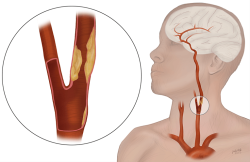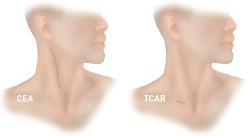Transcarotid Artery Revascularization (TCAR)
Minimally invasive approach to prevent stroke in patients that need carotid
intervention

Catawba Valley Health System is pioneering the use of a breakthrough technology
called Transcarotid Artery Revascularization (TCAR) to treat patients
with carotid artery disease who are at risk for open surgery. While any
repair of the carotid artery carries some risk of causing a stroke because
of the repair itself, TCAR was designed to help minimize that risk by
keeping potential stroke causing fragments away from the brain.
Like the open surgery, carotid endarterectomy (CEA), this new procedure
involves direct access to the carotid artery, but through a much smaller
incision at the neckline just above the clavicle instead of a longer incision
on the neck. During the TCAR procedure, a tube inserted into the carotid
artery is connected to a system that temporarily directs blood flow away
from the brain to protect against dangerous debris from reaching the brain
during the procedure. Surgeons then filter the blood before returning
it to a vein in the groin, and a stent is implanted directly into the
carotid artery to stabilize the plaque and prevent future strokes. The
entire procedure is performed in less than half the time of CEA –
limiting the stress on the heart and significantly cutting the risk of
the patient having a stroke or heart attack during the procedure.

Patients who undergo the TCAR procedure recover quickly (typically spending
just one night in the hospital) and almost always go home the next day
to return to full and productive lives with less pain, smaller scars and
a reduced risk of future strokes.
Your physician may recommend the TCAR procedure if you’ve been diagnosed
with carotid artery disease and are not a suitable candidate for CEA.
This may depend on your age or other existing medical conditions. For
more information about TCAR, call us at 828.732.5200 to schedule a consultation
with one of our vascular surgeons.
 Dr. Gener Dressler is one of only a few vascular surgeons in North Carolina
to be specially trained in TCAR procedures.
Dr. Gener Dressler is one of only a few vascular surgeons in North Carolina
to be specially trained in TCAR procedures.